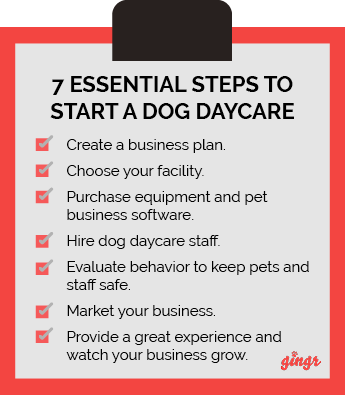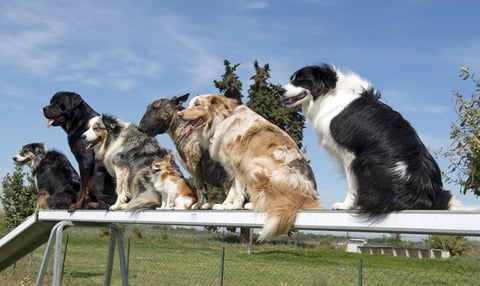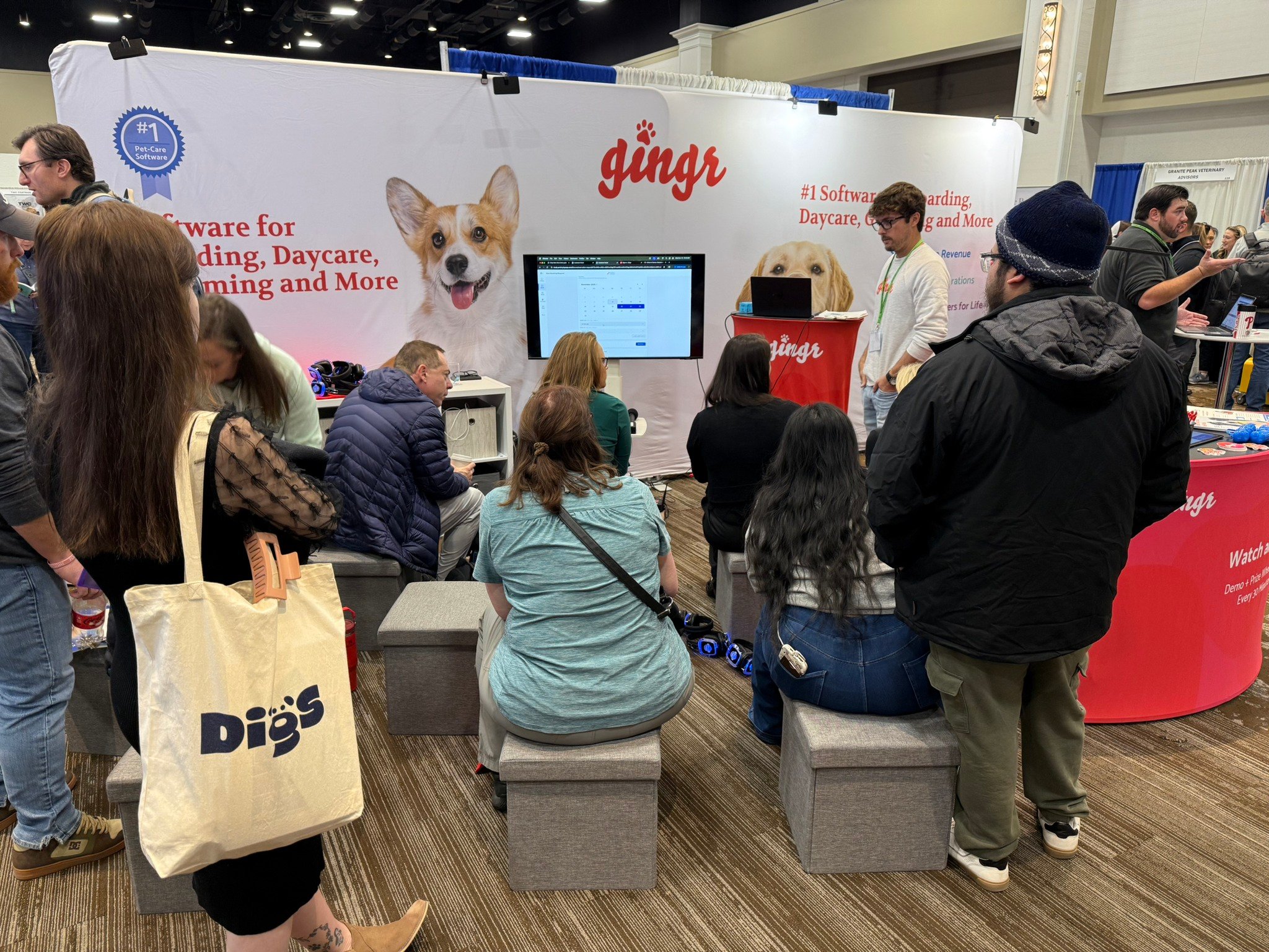You’ve been pondering it for a while, but you’re finally ready to start a dog daycare business. You’ve picked a good time —the pet industry is booming and changing, with recent trends showing a preference for niche and luxury pet care.
You’re probably itching to get moving and start inviting some canine customers into your business, but before you can open your dog daycare, there are a few things you need to know.
At Gingr, we know the ins and outs of starting a dog daycare. We’ve helped hundreds of new daycare owners streamline their management practices with our powerful dog daycare software.
We’ve seen what it takes to thrive with a doggy daycare business, and we want to help you achieve that same success with these top considerations and insider tips. We’ll cover these tips in the following sections:
- Financial Considerations for Starting a Dog Daycare
- Doggy Daycare Rules and Regulations to Know
- 7 Essential Steps to Starting a Doggy Daycare
Starting a dog daycare takes work, but is ultimately one of the most rewarding career paths for animal lovers. By following these tips, anything is paws-ible with your new business. Let’s jump in!
Financial Considerations for Starting a Dog Daycare
 When thinking about starting your dog daycare, the first few questions on your mind are probably related to the financial aspect of the business. Let’s review some of the most common financial considerations of creating and running a dog daycare.
When thinking about starting your dog daycare, the first few questions on your mind are probably related to the financial aspect of the business. Let’s review some of the most common financial considerations of creating and running a dog daycare.
How much can you make from a dog daycare?
The profitability of your dog daycare will depend on a few factors such as:
- Your ability to reach your target market
- The services you decide to offer (daytime and overnight care, training, etc.)
- How you decide to price your services
- How you manage your money once you get up and running
- The demand for your services in your community
- Your fixed and variable business costs
Ultimately, to make a profit, your revenue must outweigh your costs. Check out this dog daycare business plan guide for detailed profit equations you can use to predict your profit margins for your new business.
How much does it cost to open a dog daycare?
Opening a dog daycare will come with a few basic costs that are necessary to get started. These costs include:
- Facilities: You need space for your canine guests to play and sleep when they’re in your care. Therefore, you must purchase or rent a physical facility for your daycare business.
- Equipment: You’ll need to purchase playground equipment such as play structures, toys, and water features. Additionally, you’ll need care-related equipment such as kennels and cages, food and water bowls, dog beds, leashes, treats, and cleaning supplies.
- Staff: You’ll likely want to bring on a few staff members to help out, so one of your costs will be employee wages.
- Software and Technology: Technology is your bestie as a doggy daycare. Invest in quality dog daycare software and tools that will allow you to do online reservations, client communication, payments, and business reporting.
Although it will add to your start-up costs, investing in quality equipment upfront will save you from constantly replacing items. Plus, your customers will be impressed when they see your business utilizing state-of-the-art equipment.
What is the business model of a dog daycare?
Dog daycares rely on repeating visits from regular customers. After all, it’s much more cost-effective to secure the loyalty of a repeating customer than constantly soliciting short-term clients.
You have a few options for structuring your dog daycare business model to ensure customer satisfaction and loyalty, including:
- Pre-paid packages: Offer customers the option to purchase convenient packages. For example, many customers like to drop their dogs off at daycare while they’re at work. You can offer different tiers of prepaid packages such as three, four, or five days of daycare services per week. This way, they won’t have to pay each time they pick up their pooch, which streamlines the customer experience.
- Memberships: Invite customers to join your exclusive loyalty rewards program and offer a discount when they sign up and/or a continuous discounted rate for daycare services.
- Unique services: Offer your customers something extra that they wouldn’t normally get at other daycares, such as training or grooming services.
As you start planning for your new daycare, consider which of these business model routes you’re interested in pursuing, and incorporate it into your business plan. For example, if you want to offer special services, plan to hire a groomer or professional trainer on your staff.
How do you price dog daycare services?
It’s critical to strike the right balance with your prices to attract the widest possible range of customers.
Go too low, and your customers will worry that their precious pups won’t be receiving the highest quality of care. Go too high, and you’ll have to justify the price by offering top-quality services that customers can’t get elsewhere (which can come at a steep cost for your business). Also, if your pricing model is too complicated, it will turn off prospective clients and drive them to seek daycare services with another business.
Conduct careful market research to investigate the prices of other dog daycare facilities in your area to make sure you’re in the right ballpark for your business’s prices. Justify any price increases with enhanced services, and be sure to promote your membership or loyalty program that offers discounted rates to recurring customers.
Your pricing sends a message to prospective clients right away about the level of service they’ll get with your business, so it’s imperative to make a good first impression.
Doggy Daycare Rules and Regulations to Know
 In addition to financial considerations, legal requirements are another common concern for new doggy daycare owners. You want to make sure you’re conducting a legitimate operation that adheres to all rules and regulations. Read on for top legal considerations to know before starting your daycare business.
In addition to financial considerations, legal requirements are another common concern for new doggy daycare owners. You want to make sure you’re conducting a legitimate operation that adheres to all rules and regulations. Read on for top legal considerations to know before starting your daycare business.
Legal Requirements for Starting a Dog Daycare
You’ll have to determine a few legal characteristics of your business before you can get started. First, consider how you want to structure your business entity. You have a few choices:
- Sole proprietorship: If you’re the only one running your business, you can maintain it as a sole proprietorship. All your business activities will be under your name, making this the easiest business structure to form. However, you can be held personally liable for your business’s debts.
- Partnership: If you have one or more business partners, you may consider creating a partnership. In this structure, you and your partners share liability.
- Corporation: Corporations allow you to set up your business as a separate legal entity. In this case, your business can be held liable for debts or lawsuits rather than you. However, these are more complicated structures generally used for large businesses.
- Limited liability company (LLC): An LLC can consist of just you, your partner, or a group of people. In this structure, your personal assets are protected in most cases from any business debts or lawsuits.
Consider your long-term business goals to determine which structure you’d like to have for your doggy daycare. Once you’ve chosen your structure, register your business with your state government and consult a lawyer to help with the legal details.
Additionally, check your state and local laws and regulations to determine the licenses or permits you need to start your business. Each state has different requirements and specific health and safety regulations for animal-related businesses.
Dog Daycare Insurance
You’ll want to purchase business insurance before opening your doors to puppy pals and their caretakers. Dog daycare business insurance protects your business from liability if an accident or injury occurs.
There are three types of pet business insurance you should look into as you plan for your grand opening: commercial liability insurance, property insurance, and professional liability insurance:
- Commercial liability insurance: This insurance covers your business if an accident occurs in the daily operations of your dog daycare. For example, a customer might slip and get injured within your daycare, or a pipe could burst in your facility and damage nearby businesses.
- Property insurance: Property insurance covers your physical daycare facilities and equipment if something like a natural disaster, robbery, or fire occurs.
- Professional liability insurance: This insurance type relates to any accidents or injuries that directly relate to the activities of your dog daycare. For example, two dogs could get in a fight, or a dog could break free and run away. Professional liability insurance protects you and your business from fault in these instances.
Of course, you’ll do everything to keep customers, employees, and pups safe, but accidents happen. It’s better to be prepared ahead of time to protect yourself and your business.
Common Dog Daycare Rules
 You’ll want to set some ground rules before you open your business so customers know what to expect and what’s required before their dogs can visit. These rules are critical to mitigate risk and protect yourself and your business from liability. A few common dog daycare rules are:
You’ll want to set some ground rules before you open your business so customers know what to expect and what’s required before their dogs can visit. These rules are critical to mitigate risk and protect yourself and your business from liability. A few common dog daycare rules are:
- Age restrictions: Extremely young puppies can be at risk in a dog daycare setting, so you’ll want to specify age restrictions for your daycare, such as no pups younger than five months.
- Behavior: You don’t want to put other dogs at risk by having misbehaved or aggressive dogs at your daycare. Institute a rule that says canine guests should not have a history of aggression toward other dogs or people. You can also offer specialized play groups and individual play options for dogs with aggression or reactivity issues.
- Vaccination requirements: All dogs should be up-to-date on their vaccinations before being allowed to play or stay at your dog daycare. Use software that allows pet parents to upload vaccinations for their dogs and send them expiration notices.
As you grow your client base, organizing and maintaining all your records on each visitor will start to get complicated. Doggy daycare business software can be a major asset in helping you collect client information to reference and update as needed. Your software system will store all the important details in one place, keeping your records organized and saving you time and hassle.
7 Essential Steps to Starting a Doggy Daycare
Now that we’ve laid down a few foundational considerations, it’s time to get into the nitty-gritty of your planning process. Here are the essential steps to take to get your daycare business up and running:
 1. Create a business plan.
1. Create a business plan.
Your dog daycare business plan will be a blueprint for your business to present to prospective investors or use as a guiding document as you make strategic decisions. You can check out this guide for a full explanation of how to create a dog daycare business plan, but we’ll cover some of the highlights here.
As you create your business plan, you’ll examine the state of the dog daycare market in your local area, identify key competitors, and figure out how your business will serve an existing need to reach an untapped audience.
In this process, define your niche—your business’s unique offerings that customers won’t find anywhere else. For example, maybe you have the biggest puppy playground in town complete with a splash pad, or perhaps you offer training or grooming services to daycare customers. Defining and marketing your niche services will give your business a competitive edge and help you stand out and attract more customers.
In your business plan, fully describe your tactics for carving your place in the market and getting your services in front of prospective customers. A well-structured strategy gives a stronger argument if you present your business plan to prospective investors.
2. Choose a facility.
Once your business plan is complete, you’ll be ready to search for a home for your dog daycare business. In your search for the perfect facility, be sure to consider the following:
- Your budget: Ensure you stay in your price range in your hunt for a facility. You shouldn’t allocate all funds into leasing or facility costs because you’ll have little to spend on equipment or employee salaries.
- Your distance from your target customer base: You don’t want to be far from your target market, or no one will want to use your services. Choose a facility that is conveniently located where your customers reside.
- The amount of space you need: To run a proper dog daycare facility, you’ll need a lot of outdoor space to fit playground equipment for dogs to enjoy. Additionally, you’ll need lots of indoor space to store kennels and cages for overnight guests and have an indoor play area in case of inclement or hot weather. Your final choice of location should have enough space for all dogs to lounge and play comfortably, and for your employees to carry out their duties.
Find a space that can accommodate these considerations and also give you the room you need to grow. The more space you have, the more doggy daycare customers you can accommodate at once.
3. Acquire equipment and pet business software.
 Although you may choose to go above and beyond and offer special services, there are a few basic equipment pieces every dog daycare needs to be successful. Make sure you purchase the following items for your new business:
Although you may choose to go above and beyond and offer special services, there are a few basic equipment pieces every dog daycare needs to be successful. Make sure you purchase the following items for your new business:
- Playground equipment
- Playpens
- Toys and balls
- Kennels and crates
- Food and water bowls
- Leashes
- Poop scoopers and bags
- Cleaning supplies
- First aid kits for dogs and employees
- Laundry supplies and a washer/dryer
Besides physical equipment, you’ll want to invest in quality dog daycare business software to help manage scheduling and client relationships. Doggy daycare business software has many benefits:
- Saves time. You won’t have to spend endless hours rifling through client information or payment slips to find information. All important data is kept in one centralized place.
- Manages schedules. You can book customer appointments and manage employee schedules from your software system.
- Helps retain customers. Through your dog daycare software, you can send messages to customers and provide updates on their pets throughout their stay at your facility.
- Facilitates marketing efforts. You can draft and send automated messages using your daycare software to keep your customers and prospective clients updated on business changes or upcoming promotions.
With top-quality equipment and an easy-to-use, convenient software system, you’ll be one step closer to opening your doors to furry friends.
4. Hire dog daycare staff.
When thinking about hiring new employees for your dog daycare, you want to look for people who are dog lovers through and through. Ensure they also have specific qualifications that will make them knowledgeable and dependable employees who add value.
For example, search for prospective employees with a baseline of training in canine first aid and some prior experience caring for dogs. Employees with experience working with dogs can help create a safe environment for dogs from all backgrounds to mingle and play. You might even consider bringing on staff members with a wider range of experiences, including dog training or grooming, to give your business a unique service offering.
Last but not least, hire flexible employees who adapt to change. As your business grows, you want people on your team who can adapt to new processes quickly and effectively carry out your vision for your daycare.
5. Evaluate behavior to keep pets and staff safe.
Steps for running dog temperament tests include interviewing pet parents, conducting evaluations and observations, and taking notes to reference while assigning dogs to playgroups.
6. Market your dog daycare services to pet owners.
 Once you’ve secured your facility, equipment, and staff, there’s one more piece of the puzzle to complete your dog daycare business: finding new customers! A comprehensive marketing strategy is key to connecting with prospective customers and earning their trust.
Once you’ve secured your facility, equipment, and staff, there’s one more piece of the puzzle to complete your dog daycare business: finding new customers! A comprehensive marketing strategy is key to connecting with prospective customers and earning their trust.
Take a multichannel approach to your marketing to ensure your target audience becomes aware of your business offerings without overwhelming them on one platform. Spread the word through:
- Social media: Create a business page for your doggy daycare on Facebook and Instagram and connect with other dog daycare businesses and dog owners in your area to start growing your following. Consider purchasing social media ads to promote your business directly.
- Email: Start developing your email list by promoting your newsletter sign-up on your social media pages. Email is an effective way to reach customers directly and let them respond and ask questions.
- Direct mail/flyers: Similarly, direct mailers or flyers reach your target audience directly because you can send materials to certain addresses. Be sure to include your location, hours of operation, phone number, website, and social media handles on your mailers and flyers so people know how to reach you.
- Local radio/TV ads: If there’s room in your budget, you could consider taking out an ad spot on a local radio or TV station. Use the opportunity to introduce yourself and your staff to give your business a friendly face.
Ensure all your marketing materials are branded with your business’s logo and colors to leave your audience with a professional impression of your business. Also, lean into the playful aspect of your business. Just about everyone loves dogs and puppies, so show images or videos of puppy pals playing and having the time of their lives at your daycare to entice potential customers.
7. Provide a great experience and watch your business grow.
Your business will flourish when you take the necessary steps to create a plan for your business strategy and emphasize safety at every step. Remember that when times get tough, you can rely on your business plan to guide you through rough patches.
Prioritize proper management practices and treat your staff well to create a positive, supportive culture within your business. Customers will note your upbeat attitude and be drawn toward the cheerful, fun environment you’ve created, and you’ll retain the support of your staff during times of change or challenges.
With these tips and strategies in your toolbox, your dog daycare business will be ready to invite in a pack of hounds in no time. 
Subscribe to the Gingr Blog







